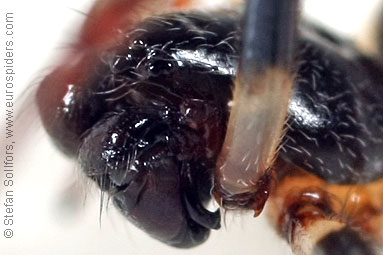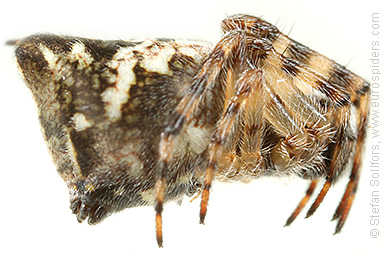Reproduction
 Unlike other organisms, the Cyclosa conica doesn’t mate
with multiple partners, they only mate with one partner, just
like us. The Cyclosa conica females choose their
mate depending on different factors, like their genotype, their
health, genetic compatibility and also the conditions of the
environment (Rittschoff et al. 2011). Male Cyclosa conicas are similar to
the females because they want to maximize their success in
reproduction (Rittschof et al. 2011). To make sure the
female doesn’t mate with other males, the male Cyclosa
conica, will block or plug up the female with his pedipalp,
or sperm-carrying organ. The blockage using the pedipalp
makes it difficult for other males to mate with the female
because after the pedipalps are inserted, they inflate making it
hard for others to remove them. For males this is an
advantage because it ensures that their genes will be passed on
(Economist 2003).
Unlike other organisms, the Cyclosa conica doesn’t mate
with multiple partners, they only mate with one partner, just
like us. The Cyclosa conica females choose their
mate depending on different factors, like their genotype, their
health, genetic compatibility and also the conditions of the
environment (Rittschoff et al. 2011). Male Cyclosa conicas are similar to
the females because they want to maximize their success in
reproduction (Rittschof et al. 2011). To make sure the
female doesn’t mate with other males, the male Cyclosa
conica, will block or plug up the female with his pedipalp,
or sperm-carrying organ. The blockage using the pedipalp
makes it difficult for other males to mate with the female
because after the pedipalps are inserted, they inflate making it
hard for others to remove them. For males this is an
advantage because it ensures that their genes will be passed on
(Economist 2003).
 Cyclosa conica females can devour the males after
mating like many other spiders. Instead of attacking the
male, the male Cyclosa conica sacrifices himself before
the female can do it herself. After he has inserted both
of his pedipalps, the male terminates himself (Economist 2003). Minutes
after the second pedipalp is insterted, his heartbeat ceases and
he dies. Since the male dies after inserting the second
pedipalp, he only has one chance at reproduction and has to make
sure he does it correctly (Economist 2003). Females can
eat the male after he dies to provide nutrients for the eggs.
In the case of Cyclosa conica, the males don’t provide
the required nutrients a female needs since the male is smaller
than the female (Blamires 2010).
Cyclosa conica females can devour the males after
mating like many other spiders. Instead of attacking the
male, the male Cyclosa conica sacrifices himself before
the female can do it herself. After he has inserted both
of his pedipalps, the male terminates himself (Economist 2003). Minutes
after the second pedipalp is insterted, his heartbeat ceases and
he dies. Since the male dies after inserting the second
pedipalp, he only has one chance at reproduction and has to make
sure he does it correctly (Economist 2003). Females can
eat the male after he dies to provide nutrients for the eggs.
In the case of Cyclosa conica, the males don’t provide
the required nutrients a female needs since the male is smaller
than the female (Blamires 2010).

Female Cyclosa conicas,
after they mate with a male, will lay her eggs in abundance.
She will cover and encase her eggs in silk, which creates the
sac. Cyclosa conica lay their eggs in the fall
and will hatch during the spring (Save Nature 2010). When springtime comes
and the Cyclosa conica begin to hatch from their eggs,
they will stay in the sac and eat a yolk material that resides
in their abdomen for nourishment. The Cyclosa conica
remain in the sac until their first molt. Once the
Cyclosa conica offspring mature, the males spend their
lives looking for a female to reproduce with, while the females
wait on their webs for the males (Saul and Julier 2010).
<<Form and Function
References
Interactions>>

